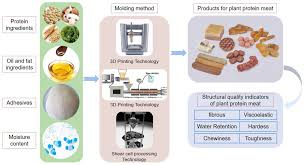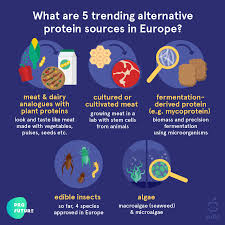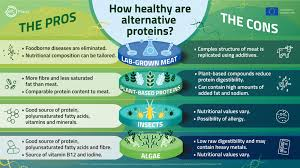ALTERNATIVE PROTEINS:
Alternative proteins, or alt proteins, are animal-free ingredients that can replace animal proteins in meat, dairy, eggs, and seafood. They are designed to mimic animal proteins in taste, texture, and culinary experience.
Types of alternative proteins:
- Plant-based proteins A food source of protein from plants like legumes, cereals, pseudocereals, and oilseeds
- Insect proteins A source of protein, fatty acids, vitamins, fibers, and minerals from insects like grasshoppers, caterpillars, beetles, and houseflies
- Mycoprotein A source of protein and fiber with a meat-like texture made from a naturally occurring fungus
- Cultured meats Meat products grown from cells sourced from animal muscle and tissue in a laboratory
- Fermented proteins Produced by converting organic substances by microorganisms or enzymes
KEY TECHNOLOGIES:
Alternative protein technologies include cell-based, plant-based, and fermentation-derived methods.
Cell-based
- Cultivated meat Uses animal cells grown in a lab to create meat products. This process uses cells from animal muscle and tissue, including fat cells, muscle precursor cells, and connective tissue.
- Biopsy-derived cells Uses a minimally invasive biopsy to obtain cells from an animal, without killing it.
Plant-based
- Soy A common source of plant-based protein, used in many cultures around the world.
- Combination of plant products Can meet the nutritional needs of a healthy person, even if individual products lack certain amino acids and vitamins.
Fermentation
- Precision fermentationUses biotechnological tools to combine the natural ability of microorganisms to ferment organic matter. This process can produce highly specific ingredients with a high degree of purity.
- Microbial proteinsDerived from single-celled microorganisms such as algae, fungi, yeasts, and bacteria.
Other technologies
- 3D printing: Used to create fibrous structures that mimic the texture of meat.
- Thermos-extrusion: Used to create fibrous structures that mimic the texture of meat.
- Cross-linking: Used to create fibrous structures that mimic the texture of meat.

ADVANTAGES AND DISADVANTAGES OF ALTERNATIVE PROTEINS:

Alternative proteins like plant-based meat substitutes and edible insects have several advantages and disadvantages.
Advantages:
- Animal welfare: Alternative proteins help avoid animal cruelty and factory farming.
- Vitamins and minerals: Plant-based proteins contain vitamins, minerals, and antioxidants.
- Carbon emissions: Alternative proteins require fewer natural inputs and produce fewer greenhouse gases than conventional protein sources like meat and fish.
- Health: Diets that rely mostly on plants for protein have been linked to a lower risk of stroke, heart disease, and early death.
Disadvantages:
Alternative proteins, such as plant-based and algae-based products, have some disadvantages, including:
- Nutrition: Some plant-based products are high in sugar and low in micronutrients.
- Taste and texture: Plant-based proteins may not taste or feel like meat.
- Processing: Highly processed plant-based products can be high in sodium and saturated fat.
- Anti-nutrients: Anti-nutrients in plants can make it harder to digest protein and absorb micronutrients.
- Heavy metals: Algae can contain heavy metals.
- Cost: Some alternative proteins are expensive, which makes them impractical for large-scale food production.
- Consumer perception: Some consumers may not like the taste, texture, or origin of alternative proteins.
- Regulation: Regulation of alternative proteins is variable and not well developed.
- Ethical concerns: Some people have concerns about whether insects can feel pain.
USES:

Alternative proteins have many uses, including reducing the environmental impact of animal agriculture, improving human health, and providing a sustainable food source.
Health benefits
- Lower risk of disease Alternative proteins can help reduce the risk of heart disease, type 2 diabetes, and certain cancers.
- Improved nutritional profile Alternative proteins can have a better nutritional profile than meat, such as less saturated fat and cholesterol.
- Improved public health Alternative proteins can help reduce the risk of zoonotic diseases and antibiotic resistance.
Environmental benefits
- Less pollution: Alternative proteins produce less air and water pollution than conventional meat production.
- Less waste: Alternative proteins produce less waste than conventional meat production.
- Less demand for animal resources: Alternative proteins reduce the demand for animal resources such as land, water, and feed.
Examples of alternative proteins
- Cultured meat: Also known as lab-grown meat, this is produced by growing animal cells in a controlled environment.
- Algae: This protein-rich food can fix carbon dioxide and use less soil than the livestock industry.
- Mycoprotein: This meat substitute is made by fermenting filamentous fungi.
- Beans and legumes: These are a rich source of fiber and B vitamins.
- Soy: A cup of boiled soybeans contains around 29 grams of protein.
